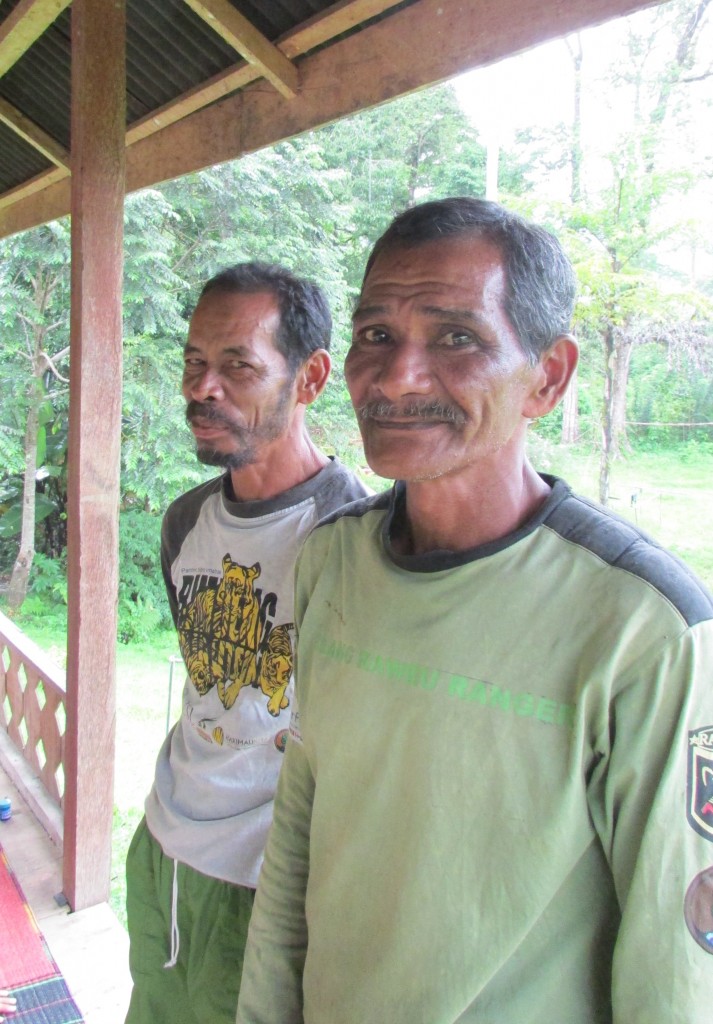Norman et Burhan
This portrait is a little different because it is an interview of two people at the same time. Norman and Burhan, are Community Rangers (more or less the equivalent of our park rangers) for Flora and Fauna International (FFI, see project description). Norman and Burhan were my guides for two treks, two to three days long through the jungle. They know the forest by heart, and know all the local villagers and farmers personally. I had originally planned on writing two separate portraits, but I knew it would not be possible. Mainly because Norman was much more comfortable speaking with me than Burhan, and also because they are friends who have known each other since childhood and have shared similar life paths. They are both from villages near Mane and look quite serious, which, initially, made them hard to approach. After a few days getting to know them I began to see their smiles and understood their kind nature. It was very difficult to make this portrait about them because they hardly spoke about their emotions, but it did make it more interesting.
When talking about elephants, both Norman and Burhan describe them as amazing animals. Their story with the elephants began together. Their first encounter with wild elephants happened when they were with several people fishing in the forest. It was a little over five years ago, before the creation of the Conservation Response Unit (CRU see project description) of Mane. They were frightened when they first saw the elephants, “but since we have had the opportunity to work closely with domesticated elephants, we better understand their behavior and we have no fear during our encounters with wild elephants.”
Before working for FFI as Community Rangers, Norman and Burhan were poachers; they hunted dear in the forest to earn money for their families. The FFI team met them during one of their expeditions in the forest. First, the team explained why poaching was prohibited and why it was harmful to hunt deer. Next, they offered them jobs at FFI as Community Rangers. FFI has launched an extensive program to teach the importance of the local environment and how to use tools like GPS to the local community. The mission of the Community Rangers is to patrol the forest and identify any illegal activity, they support law enforcement in environmental conservation, and increase local awareness of the need to protect the environment. In return, FFI pays the Community Rangers money, but also supports them in the development of other subsidiary activities sush as the development of a herd of cattle in order to prevent the need to go back to previous illegal activities.
Today, Norman and Burhan say they, “know a lot more about the fauna and flora and do not want to start deer hunting again.” They have learned to love the elephant and “do not want to see them killed in retaliation of a conflict. We try to respond as quickly as possible to a conflict so that people do not have time to kill or injure the elephants.” They told me they are not very close to the domestic elephants, but they are working with the mahouts (elephant trainers) to find solutions when conflicts arise. The conflicts, they say, come from agricultural encroachment on the elephant habitat. They tell me that in their interventions, they try to explain the causes of elephant conflicts to the local people, while some people agree (human-elephant conflicts in the villages near the CRU have almost completely diminished), others from more distant villages seem to accuse the CRU and say that the presence of domesticated elephants “repel the wild elephants, so they now come to the villages and attack the fields.” Norman explains that this is false because “the group of wild elephants, blang raureu [the name given to the group of elephants close to the CRU] still lives near the camp. The conflicts that are occuring farther away do not come from the same group of elephants.” These criticisms are isolated cases and all of the nearby villagers are happy with their response. When I asked Norman and Burhan what they feel about the topic they repeated, “happy.”
They are also very “happy” to work with the CRUs (“happy” is the word they used every time I asked them to talk about their feelings). At first, the Community Rangers camps were permanently located at the CRU, but today they mainly work at the camps only when a conflict arises because the “local people need them.” They evaluate their time with the team of mahouts and work together about ten days per month. When I asked them about the future of the CRU, they told me the project could be further developed. For example, they recently participated in several meetings with the local government in order to improve the local laws to protect the elephants habitat. One topic of discussion was banning new crops that require farmers to further cut down the forests. When they spoke of the future, they shared their concerns about their work with FFI. Unfortunately, the project with the Community Rangers stops in June and there are still many uncertainties. If their contract is not renewed, revenues from subsidized developments are, according to them, not enough. However, they confirmed that even without a contract, they will continue to help the CRUs in their work and help with human-elephant conflict interventions.

